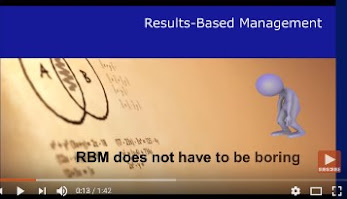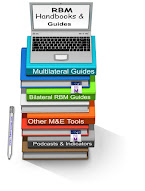Results-Based Management in UNIFEM: Essential Guide
--Greg Armstrong--
[ This post edited to update links, July 2018 ]
 |
| The UNIFEM RBM Guide |
Level of Difficulty: Easy
Primarily Useful for: Introducing partners to elementary RBM concepts
Limitations: No access to the associated training modules, limited detail on procedures
Length: 34 pages
Most Useful sections: p. 16-22
UNIFEM’s RBM guide was produced in 2005 as a draft, intended for use by UNIFEM staff and partners. When I did a week of results-based management training with UNIFEM in 2006, in Bangkok, I found that none of the participants were aware of the document. This was unfortunate because, while it is very basic, it is also quite accessible and could have been useful, not just for UNIFEM staff themselves, but for field staff and any partners who want an introduction to the basics of results-based management.
The draft document is designed to be used with a series of modules for further training, but those are not, as far as I can see, available to the general public. Without those modules, the utility of the Guide is limited, but it still provides a non-threatening introduction to results-based management terms.
Basic RBM concepts
As a results-based management guide, the UNIFEM material is, as I noted earlier, very basic and appears to be aimed at people with little or no background in RBM. There is some UNIFEM - and UN-specific terminology scattered throughout the document (discussion of Multi-Year Funding Frameworks, for example), but this should not put off readers who are not familiar with the terms. Much of the document is jargon-free.
There is not a lot of detail on individual components of results-based management covered here, but of all of the RBM guides produced by donors, this is among the easiest to understand, perhaps because it is so limited in scope. There are many other places readers can look for detail and complexity.
No doubt some donors with more sophisticated RBM or Managing for Development Results frameworks will not be impressed. But the problem with these other frameworks is that they are often context-specific and use technically obscure RBM terms. Many cannot be used by people outside the organization or even by people inside the organization, who may have limited tolerance for bureaucratic jargon. The UNIFEM guide is simple, but not simplistic, and it does at least introduce some elementary and important RBM terms and concepts in terms people not obsessed by RBM can understand.
The most of important of the concepts the Guide introduces is about how results-based management should be used. UNIFEM acknowledges in the guide what other agencies, in their more sophisticated approaches to RBM, often forget: that results-based management can be the most powerful where it is used not primarily as a technical planning tool, but as an opportunity for partners to come together for participatory planning. This is explained in other websites in more detail, but often ignored in practice.
Results Context
What follows in the next 25 pages, are short discussions of the development of a results chain, phrasing of results statements, indicator development and planning for monitoring and evaluation.
Results Statements
Reading the section titled “The nuts and bolts of developing results statements” (pages 16-19) is something that could be useful not just to people new to RBM, but as a refresher on clear writing for a lot of development practitioners who get tied up in ponderous results statements. This section emphasises the use of plain, understandable language, and the need for realistic results that might plausibly be achieved given the resources of time and money available. This is something that, in my experience in project design, monitoring, and results-based management training a lot of donors and implementing agencies stumble on - complex and implausibly grandiose results statements.
The section of the Guide on results reporting (p. 26-30) is largely oriented to UNIFEM requirements, but the very brief section on “The difference between reporting on results, reporting on process, and reporting on activities” on pages 28-29 reiterates a point that any implementing agency could usefully review. Many UN agencies have a real problem of credibility on results at the project level because they hold themselves accountable only for completed activities (Outputs). But UNIFEM, while it acknowledges this, does move beyond activity completion and both in the Guide (and in its implementation in the field, from what I have seen) genuinely tries to understand whether its activities have led to results (Outcomes).
Indicator Development
The section on “development of results indicators” (p. 19-22) is useful as an introduction. Some of the indicator examples, however, use the kind of vague language that, on the whole, can come back to haunt an agency (as has happened with UNIFEM on occasion) as it comes to collect the data. For example, the following is cited as an output indicator:
“Number and quality of analyses of gender discriminatory provisions of national legislation undertaken by women’s organizations“.UN agencies often use the “number and quality” indicator, but while the “number” can work, “quality” always requires more explanation - which means yet another level of indicators, or targets, if we are going to be able to specify what the criteria for “quality” will be. This doesn’t mean we shouldn’t look at quality, just that we need to be specific about what we mean when we use the word.
The Bottom Line:
Despite its limitations, for agencies or individuals coming to RBM for the first time, or simply rebounding from the unintelligible material often served them by donors, this UNIFEM Guide is a useful place to start. Where they go from here is another issue, but beginning with this, might leave readers interested, rather than intimidated, and increase the likelihood that they will pursue more detailed and substantive investigations of RBM.
[ Update Note: June 2011 - Since the creation of UN Women in 2010, the links to the original UNIFEM site have disappeared or been redirected. The UNIFEM RBM Guide is no longer listed on the UN Women site, but a copy of the UNIFEM RBM Guide is available on SCRIBD. ]
_____________________________________________________________
GREG ARMSTRONG
Greg Armstrong is a Results-Based Management specialist who focuses on the use of clear language in RBM training, and in the creation of usable planning, monitoring and reporting frameworks. For links to more Results-Based Management Handbooks and Guides, go to the RBM Training website.
QYEMDCUX5F4G
[ Update Note: June 2011 - Since the creation of UN Women in 2010, the links to the original UNIFEM site have disappeared or been redirected. The UNIFEM RBM Guide is no longer listed on the UN Women site, but a copy of the UNIFEM RBM Guide is available on SCRIBD. ]
_____________________________________________________________
QYEMDCUX5F4G






